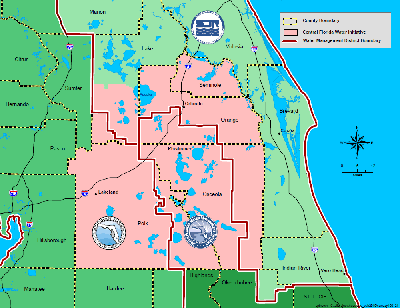|
Fall 2016
IN THIS ISSUE
d&G Lawyer News
Educational Workshops
Interested in a seminar on a recurring legal issue confronting your company?
Contact our event coordinator,
to learn more about our educational workshop options.
Visit Our Site:

101 E. Kennedy Blvd.,
Suite 2000
Tampa, FL 33602
813-229-2775
|

Central Florida Water Initiative Update
By: Kristin Melton
In December 2013, the Florida Department of Environmental Protection (“FDEP”) released a
Guidance Memo requiring coordination on all pending consumptive use permitting (“CUP”) applications within the area
previously referred to as the Central Florida Coordination Area (“CFCA”).
This area includes southern Lake, Orange, Osceola, Seminole and Polk Counties and is governed by three water
management districts – the St. Johns River Water Management District (“SJRWMD”), Southwest Florida Water
Management District (“SWFWMD”), and South Florida Water Management District (“SFWMD”).
Recognizing the need to continue prior efforts within the CFCA, the Central Florida Water Initiative (“CFWI”)
was established to develop and implement an effective and consistent method for water resource planning, development
and management throughout the area. Through the guidance of the CFWI, the three water management districts,
along with the FDEP, Florida Department of Agriculture and Consumer Services (“DACS”), regional public water
supply utilities and other stakeholders have been collaborating to develop a unified process to address
central Florida’s current and long-water supply needs.
The CFWI’s principles and goals served as the framework for development of the January 2015 CFWI Guiding Document.
During the 2016 Legislative Session, the state passed a comprehensive water policy bill (SB 552),
which effectively incorporates the findings in the 2015 CFWI Guiding Document and amends Section 373.0465(2)(d),
Florida Statutes, to require adoption of uniform rules in the CFWI for:
- A single, uniform definition of the term "harmful to the water resources” consistent with the term’s usage in s. 373.219;
- A single method for calculating residential per capita water use;
- A single process for permit reviews;
- A single, consistent process, as appropriate, to set minimum flows and minimum water levels and water reservations;
- A goal for residential per capita water use for each consumptive use permit;
- An annual conservation goal for each consumptive use permit consistent with regional water supply plan.
Following this legislative direction, the CFWI Regulatory Team split these six requirements into the following topic groups:
- Conditions for issuance;
- Uniform definition of harm;
- Uniform demand calculations (utility, ag, industrial);
- Landscape irrigation restrictions;
- Addressing potential impacts outside of the CFWI boundary;
- Uniform conservation requirements (utility, ag, industrial);
- Use of MFLs and reservations in the permitting process;
- Single permitting model tool;
- Permitting Thresholds; and
- Permit Conditions.
Over the past few months, the CFWI regulatory team and topic groups have been working to develop revised rules
addressing each of these topics. One topic area that has consistently raised questions regarding its potential
impact outside of the CFWI boundary is the proposed uniform definition of harm.
While the exact language is still in development, the proposed uniform definition includes the
following criteria: adverse water quality impacts to a water source resulting from a withdrawal or diversion;
adverse water quality impacts from a dewatering discharge to receiving waters; adverse impacts from saline
water intrusion or upconing; and hydrologic alteration that results in adverse impacts to the natural system,
including wetlands or other surface waters. Stakeholders have submitted comments expanding on the definition
s of these four criteria and consideration of including language requiring applicants to provide reasonable
assurance that these impacts will not occur as a condition for issuance in consumptive use permits.
Because the water management districts have struggled with defining “harm,” it is likely that these definitions
will be incorporated into water management district rules for areas located outside of the CFWI.
Therefore, even those entities located outside of the CFWI may find it valuable to participate in development of these criteria.
Additionally, the CFWI has been working to develop uniform demand and uniform conservation rules.
With respect to utility demand, much of the discussion has centered on using various per capita measurements depending on the ultimate use.
Uniform conservation concepts include changes to year round irrigation rules, smart irrigation controllers,
a goal for residential per capita water use for each CUP, and an annual conservation goal for each CUP
consistent with the regional water supply plans. Because of the potential breadth of the concepts, it is again
likely that any changes adopted as part of the CFWI consistency requirements may also be reflected in water
management district rules for areas outside of the CFWI.
These are only brief examples of some of the rulemaking efforts the CFWI has been engaged in.
The legislative directives are expansive in scope and critical to the future of water supply in central
Florida and may have impacts across the state. Therefore, interested stakeholders are encouraged to learn
more about the CFWI and participate in the rule development process.
If you have any questions regarding the CFWI process and how it may impact you, please email
Edward de la Parte (edelaparte@dgfirm.com), Nick Porter (nporter@dgfirm.com), or Kristin Melton
(kmelton@dgfirm.com) or call 813-229-2775.
|



